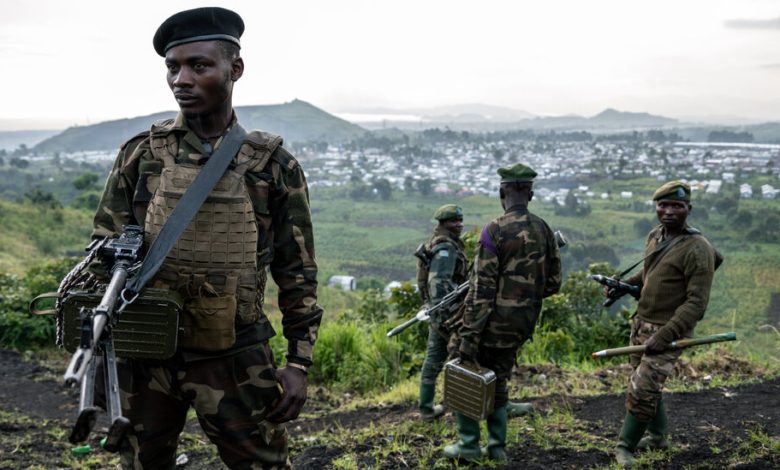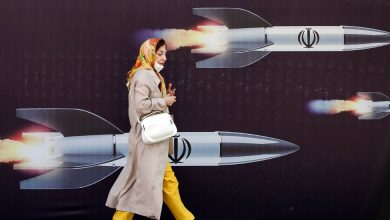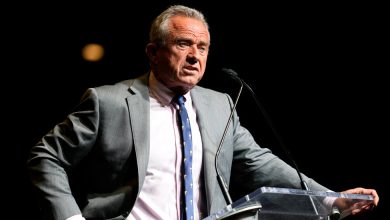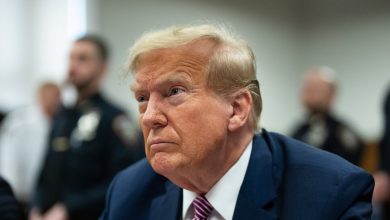The Overlooked Crisis in Congo: ‘We Live in War’

Artillery boomed, shaking the ground, as a couple scurried through the streets of Saké, their possessions balanced on their heads, in the embattled east of the Democratic Republic of Congo.
At a crossroads, they passed a giant poster of Congo’s president, Felix Tshisekedi, who is standing for re-election on Dec. 20. “Unity, Security, Prosperity,” read the slogan. They hurried along.
“Our children were born in war. We live in war,” Jean Bahati, his face beaded with sweat, said as he paused for breath. It was the fifth time that he and his wife had been forced to flee, he said. “We’re so sick of it.”
They joined 6.5 million people displaced by war in eastern Congo, where a conflict that has dragged on for nearly three decades, stoking a vast humanitarian crisis that by some estimates has claiming over six million lives, is now lurching into a volatile new phase.
Making sense of the mayhem is not easy. Over 100 armed groups and several national armies are vying for supremacy across a region of lakes, mountains and rainforests slightly bigger than Florida. Meddlesome foreign powers covet its vast reserves of gold, oil and coltan, a mineral used to make cellphones and electric vehicles. Corruption is endemic. Massacres and rape are common.
For all that, aid groups struggle to draw attention to the suffering in a country of about 100 million people, even when the numbers affected dwarf those of other crises.
“There’s a sense of fatalism about Congo,” said Cynthia Jones, the World Food Program head in eastern Congo. “People seem to think ‘that’s just the way it is’.”
However this latest phase of the war, which began in earnest two years ago, is drawn in unusually clear lines.
On one side is the M23, a well-organized but ruthless rebel group that the United States and the United Nations say is backed by Rwanda, Congo’s eastern neighbor, which is one-hundredth the size of Congo. (Rwanda denies any link.) Since October, the M23 has seized the main roads into Goma, the regional capital, as well as the hilltops overlooking Saké, 10 miles to the west.

People fleeing fighting this month pass an election poster for Congo’s president, Felix Tshisekedi, in Saké. Parts of eastern Congo are so unstable that voting has been canceled there.
On the other side is Congo’s army, whose troops are notoriously ill-disciplined — even as fighting raged near Saké last week, drunken soldiers careened through its streets. But their strength is boosted by two new allies.
One is the Wazalendo, Swahili for patriots, a coalition of once-rival militias that the government cobbled together to repel M23, despite the fighters’ reputation for factionalism and brutality.
The second is a force of about 1,000 Romanian mercenaries, many formerly with the French Foreign Legion, deployed around Goma and Saké. If M23 tries to seize the city — as it briefly did once, in 2012 — the Romanians are charged with defending it. “They are the last line of defense,” Romuald, a retired French officer advising the Congolese military, said at a lakeside restaurant in Goma. He asked to omit his surname to protect his security.
Amid all that, an election is taking place.
Mr. Tshisekedi, who is favored to win the presidential race, initially pushed for peace after his election in 2019, following a disputed vote. But that effort failed, and now he is aggressively stoking public hostility toward Rwanda, including personal attacks on its leader, President Paul Kagame.
“Kagame must die!” supporters chanted at a rain-soaked rally last Sunday in Goma, where Mr. Tshisekedi arrived by boat after crossing Lake Kivu. At an earlier rally, he had likened Mr. Kagame to Adolf Hitler — a comparison that a Rwandan government spokeswoman called “a clear and present threat.”
Rwanda and Congo appeared on the verge of open war in January, after Rwanda fired missiles across the border at a Congolese fighter jet as it landed at Goma airport. Now, though, the greatest danger is faced by Congolese civilians plunged into yet another round of misery.
Over half a million people have fled their homes in just the past two months, mostly into the squalid camps that have sprung up around Goma. A sea of rough huts, fashioned from sticks and tarpaulins, is expanding across plains littered with sharp black lava rocks. Mount Nyiragongo, an active volcano that forms a dramatic backdrop to Goma, bubbles in the distance.
Foul-smelling sludge runs between shelters. Disease outbreaks threaten. Food is scarce. The World Food Program says it has enough to feed only 2.5 million of the estimated 6.3 million people who go to bed hungry every night in eastern Congo.
Even soldiers are struggling. At the dilapidated public hospital in Saké, a wounded soldier, Jules Amundala, dozed on a filthy mattress, nursing a bullet wound in one leg. Mr. Amundala, 26, said he had been shot in an ambush that killed his commander. But his main concern was food — the hospital hadn’t been able to feed patients for several days, doctors said.
In a region where the gun trumps the law, women are especially vulnerable. From the camps around Goma, many trek to the nearby Virunga National Park, famed for its mountain gorillas, in search of firewood. What they often find, though, are gunmen.
“They gave me a choice,” said Amani, 42, recalling an encounter with three armed men in the park on Dec. 8. “They said, ‘either we attack you, or we kill you.’”
“I said I prefer to be raped.”
The mother of seven stumbled back to her hut in a displaced camp afterward, bleeding heavily. A day later, she reached a clinic run by Doctors Without Borders, where she spoke, asking to be identified only by one name.
She said it was the second time she had been raped by gunmen in the war. The pile of wood she had gone to fetch, to help feed her children, was worth $2.
In October, Doctors Without Borders treated on average 70 sexual assault victims every day at its clinics in Goma, a spokeswoman said. In the broader North Kivu region, it has treated at least 18,000 cases this year.
Congo’s agony started with the 1994 genocide in Rwanda. After the slaughter that took 800,000 lives, a flood of refugees crossed into Congo, bringing turmoil that eventually toppled its kleptocratic leader, Mobutu Sese Seko, and led to a ruinous civil war.
Three decades on, the genocide’s shadow lingers in Congo. Justifying his cross-border interventions, Mr. Kagame of Rwanda says he is still hunting the ethnic Hutu killers, hiding in Congo, who carried out the 1994 killings.
But economic and strategic interests matter too. Rwanda has long seen eastern Congo as its strategic backyard — the Rwandan capital, Kigali, is just 60 miles from Goma — and a source of income. Congo’s finance minister says his country loses $1 billion a year from smuggling of gold and other precious minerals through Rwanda.
Amid such chaos, maintaining even a facade of democracy is hard: In the Rutshuru and Masisi districts north of Goma, 1.5 million people will not be able to vote in Wednesday’s election because the M23 controls those areas.
Still, the M23 is hardly the only threat to the peace. In the Virunga National Park, rangers are trying to hold off groups pressing in from every side, poaching animals and seizing land. Over 200 rangers have been killed, often in clashes with armed groups.
“Where you see that fire burning, it’s F.D.L.R.” the park director, Emmanuel de Merode, said recently as he piloted his Cessna plane over the park, referring to a notorious Hutu militia. “In those hills, it’s the Mai-Mai. And between here and the mountains, it’s M23.”
Directly under the plane, elephants lounged by a lake.
At a fortified base in Nyamitwitwi, near the border with Uganda, rangers piloted a drone along the park’s perimeter fence. Militants attacked here last month, tearing down five miles of fence, Elia Muvulia, the camp commander, said.
After a fight, the rangers got it back up.
When the M23 last mounted a major offensive, a decade ago, the United States led efforts to roll it back. President Barack Obama and other officials cut aid to Rwanda, and personally called Mr. Kagame, to apply pressure.
This time, the West is divided: The United States is openly critical of Rwandan intervention in Congo, and recently cut some military aid to Rwanda. But Britain, whose government is trying to deport asylum seekers to Rwanda, has been largely silent.
A rare hope for peace emerged on Monday when the White House announced a 72-hour pause in the fighting around Goma.
Romuald, the French military adviser, said the truce had been precipitated by the arrival of a powerful new weapon: Chinese drones, recently acquired by Congo, that he said had struck Rwandan troops near Goma last weekend.
Pulling out his cellphone, he played a video that showed a missile striking dozens of soldiers clustered on a hillside. The footage could not be independently verified, although a Congolese military spokesman confirmed his assertions.
A spokeswoman for the Rwandan government did not respond to questions about the strike.
The French adviser called it a new stage in Congo’s long wars. If Rwandan troops do not withdraw, more attacks will follow, he said.
“We’re going to strike, strike, strike, strike,” he said.



